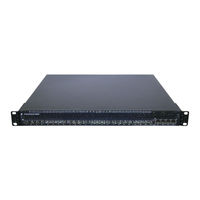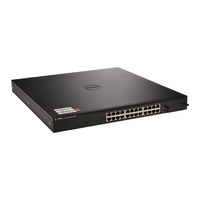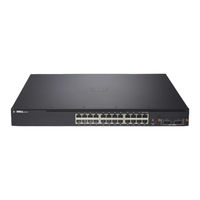Dell PowerConnect 8132F Manuals
Manuals and User Guides for Dell PowerConnect 8132F. We have 6 Dell PowerConnect 8132F manuals available for free PDF download: User Configuration Manual, Release Note, Manual, Configuration Manual, Specifications
Dell PowerConnect 8132F User Configuration Manual (1294 pages)
Table of Contents
-
-
-
Log Messages55
-
Sflow58
-
-
Ssh/Ssl62
-
-
-
VLAN Routing77
-
-
Ipv6 Routes80
-
Ospfv380
-
Dhcpv680
-
-
-
IGMP Proxy84
-
-
-
-
Switch Addresses100
-
The Switch101
-
-
-
-
-
-
-
-
-
Stack Summary157
-
NSF Summary162
-
-
-
-
AAA Overview179
-
Methods180
-
Access Lines181
-
-
-
Authentication181
-
Authorization182
-
Accounting184
-
-
-
-
-
Information205
-
-
-
-
CLI Banner246
-
Clock248
-
SNTP Server252
-
Slot Summary258
-
Supported Cards259
-
-
SNMP Overview273
-
What Is SNMP273
-
-
-
Communities285
-
Trap Flags291
-
Trap Log294
-
-
-
-
-
File System316
-
Active Images317
-
USB Flash Drive318
-
File Download319
-
File Upload321
-
Copy Files323
-
-
-
-
Advertisement
Dell PowerConnect 8132F User Configuration Manual (1266 pages)
Table of Contents
-
-
-
Log Messages54
-
Sflow57
-
-
Ssh/Ssl61
-
-
-
VLAN Routing76
-
-
Ipv6 Routes79
-
Ospfv379
-
Dhcpv679
-
-
-
IGMP Proxy83
-
-
-
-
-
Port Leds95
-
System Leds96
-
-
-
-
-
-
-
-
-
-
Stack Summary155
-
NSF Summary160
-
-
-
-
AAA Overview177
-
Methods178
-
Access Lines179
-
-
-
Authentication179
-
Authorization180
-
Accounting182
-
-
-
-
-
Information203
-
-
-
-
CLI Banner244
-
Clock246
-
SNTP Server250
-
Slot Summary256
-
Supported Cards257
-
-
SNMP Overview271
-
What Is SNMP271
-
-
-
Communities283
-
Trap Flags289
-
Trap Log292
-
-
-
-
-
File System314
-
Active Images315
-
USB Flash Drive316
-
File Download317
-
File Upload319
-
Copy Files321
-
-
-
Dell PowerConnect 8132F Release Note (74 pages)
5.1.0.1 Firmware Release Notes
Table of Contents
-
Known Issues60
Advertisement
Dell PowerConnect 8132F Configuration Manual (17 pages)
Switch Configuration Guide for EqualLogic SANs
Table of Contents
Dell PowerConnect 8132F Specifications (3 pages)
PowerConnect 8100 Series high-performance 10/40 GbE Enterprise Switches
Advertisement





